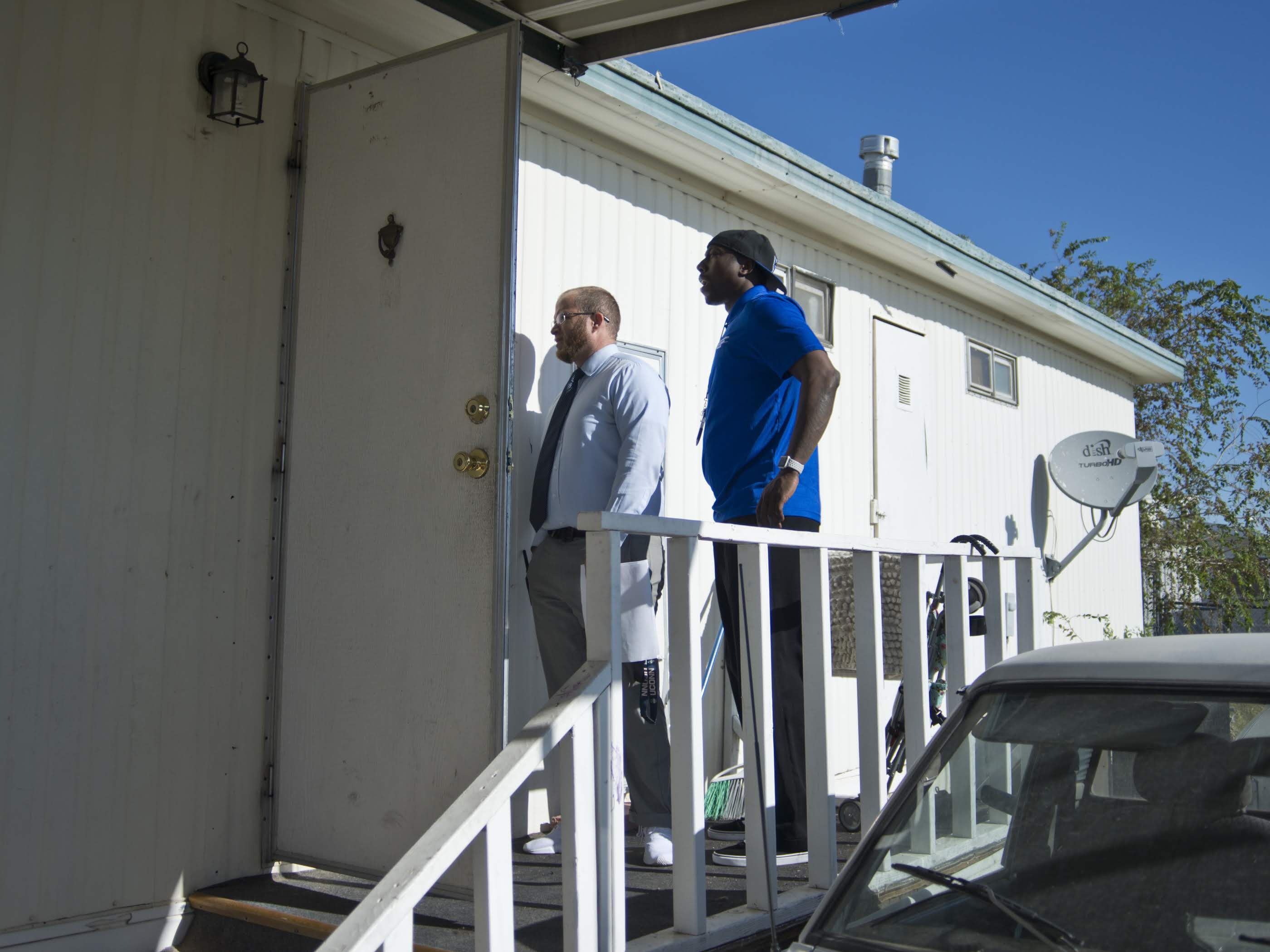'It's not a kid issue': Why an elementary school is using home visits, virtual reality to combat chronic absenteeism

The blinds were drawn and all was quiet when Ryan Smith and Cornell Williams scaled the steps to a white mobile home on a recent weekday morning.
Despite exterior evidence suggesting otherwise, the two men had reason to believe someone might be home. That someone was a kindergarten girl who already had missed 11 days at nearby Manch Elementary School in northeast Las Vegas. So like hopeful solicitors, they knocked on the door.
But Smith, a school counselor, and Williams, a Communities in Schools site coordinator, weren’t here to peddle a product. They came to sell a message that could pay dividends over time: The more often your child attends school, the better he or she will do academically.
Slowly, the door cracked open and a young woman appeared.
“Is mom home?” Smith asked.
“No, she’s at work,” the woman replied. “I’m babysitting.”
It was enough of an opening for Smith to launch into his education sales pitch. The kindergartener’s frequent absences just six weeks into the school year, he said, were jeopardizing her education.
“We would obviously love for her to get back to school,” he said.
The woman promised to call the children’s mother and relay the message. This wasn’t the school’s first interaction with the family, though. The girl’s older sister, now a sixth-grader, had missed more than 30 days of school last year, prompting Manch officials to send a letter warning about the possibility of an educational neglect complaint, which could trigger a Child Protective Services investigation.
The older girl’s attendance improved afterward. But on this warm September morning, Smith and Williams spotted her inside the home.
“Get to school!” Williams shouted in a friendly manner as they left.
One home visit down, four more to go. The duo hopped into Smith’s Honda-CRV and keyed up the next address on a cell phone, with Smith serving as driver and Williams as navigator. They call themselves “good cop, bad cop” as they tag team their way through the stops. Smith, dressed in a collared shirt and tie, leads the conversations, delivering the message while trying to ascertain the family situation causing the absences in the first place. Williams, wearing a backwards baseball hat and warm smile — the kind that makes you feel like you’ve known him forever — jumps in to smooth over any rough edges.
The home visits have become part of their weekly duties this year. They’re an element of a multi-pronged approach to curbing chronic absenteeism at this 900-student elementary school.
By mid-September, 52 students had missed at least five days of school.

***
On weekdays, North Lamont Street swarms with children. Two elementary schools sit next door to each other. Manch, the original but remodeled school, educates the children living in odd-numbered addresses, while Lowman Elementary School serves students with even-numbered addresses.
It’s the only way education officials could ensure zoning equity within this low-income neighborhood. Nellis Air Force Base sits just to the north, but most families here have little or no connection to the military. Aging fourplexes, sprawling apartment complexes, weekly rentals, mobile home parks and a smattering of single-family homes — some new and some old — occupy the school zone.
More than a quarter of residents living in the area never graduated high school, according to a county analysis of U.S. Census Bureau data from 2015. On land tracts within the school zone, the median household income ranges from $22,697 to $41,133.
Three years ago, a nearby Walmart Supercenter abruptly closed, further limiting access to food.
School officials acknowledge it’s a difficult neighborhood, brimming with poverty and transiency. The home visits are offering Manch staff a window into their students’ worlds.
“I like them just for the fact that we get to see where they are living,” Smith said. “A lot of our students are coming from tough situations.”
But Manch Principal Brandon Danowski hopes the visits go a step further and curb the school’s high rate of chronic absenteeism. Roughly 40 percent of students at Manch and Lowman are considered chronically absent, meaning they’ve missed 10 percent or more school days. Over the course of an academic year, that pencils out to 18 days.

While Manch and Lowman have among the highest chronic absenteeism rates, the problem plagues the entire Clark County School District. Twenty-two percent of students district-wide are chronically absent, a rate that’s higher than both the state (19 percent) and nation (14 percent).
To put it a different way: More than 1 in 5 Clark County children are chronically absent.
The Obama-era Every Student Succeeds Act (ESSA) requires schools and districts to report chronic absenteeism, which has magnified interest in the problem that carries repercussions for students and schools alike. Research has shown that students who miss lots of class are less likely to read at grade level or graduate high school. Schools suffer because chronic absenteeism factors into their overall star rating in the Nevada School Performance Framework. (Manch and Lowman, the side-by-side elementary schools with high rates of chronic absenteeism, both received a one-star rating this year.)
The school district may receive extra resources to combat chronic absenteeism thanks to a recent sales-tax increase recently approved by the Clark County Commission. Assembly Bill 309 gave commissioners the power to increase the sales tax to fund specific education or social service initiatives, truancy reduction among them. Earlier this month, commissioners approved a one-eighth of a cent sales tax increase, but that money will be doled out in the form of grants.
Commission Chair Marilyn Kirkpatrick said the board plans to discuss funding for truancy-reduction efforts next month. She said the county, which received more than 2,000 complaints of educational neglect last year, wants to take a leadership role.
“We want to be on the front end,” she said.
So what’s driving kids to miss school?
Dr. Steven Sheldon, an associate professor at Johns Hopkins University who studies family and community engagement, said a myriad of underlying issues contribute to chronic absenteeism. Chaos in the classroom or boredom may cause students, especially in older grades, to lose interest, he said. But chronic illnesses and family dynamics, such as parents’ work schedules or conflicts in the home, play a role, too.
The varying reasons make it that much more difficult to treat.
“Chronic absenteeism is this ecologically made phenomena,” he said. “At least from my experience, it’s very unlikely that there’s going to be any one silver bullet.”
Danowski agrees, which is why Manch has deployed a wide range of approaches.
***

On a recent morning, fourth-graders donned headsets in a darkened classroom at Manch. Their heads bobbed and they let out occasional gasps while exploring a world map showing earthquake locations.
This is the school’s new virtual reality lab — a place where students can immerse themselves in a European city, deep underwater by the Great Barrier Reef or inside the body’s circulatory system among other destinations. The lab, a first in Clark County, was years in the making, fueled by Danowski’s desire to bring new experiences to Manch students, many of whom rarely leave the neighborhood.
For now, the virtual reality lab is tied to curriculum. Students in the fourth-grade class, for example, have been comparing and contrasting tsunamis and earthquakes to build that literacy skill — hence their trip to the virtual reality lab to learn more about the ground-shaking natural disaster. But Danowski has been contemplating other ways to use the lab as an attendance incentive, such as inviting students and their families to go on a “virtual vacation” if they don’t miss school.
“It’s super-helpful letting them know they need to be here for virtual reality time,” said Mary Beach, who teaches fourth grade.
The virtual reality lab, arguably, is the most kid-friendly approach the school has pioneered to lure students to the classroom. But in an elementary school where a quarter of the students heading toward chronic absenteeism are kindergartners, educators know the problem isn’t a 5-year-old who’s refusing to attend school. By and large, the younger students show the most enthusiasm about school.
“It’s not a kid issue,” Danowski said. “It’s circumstances a lot of times out of the kids’ hands.”
Last year, Manch partnered with Boys Town Nevada, a nonprofit focused on child and family care. Boys Town brought its “Lift Together” program to the northeast valley school, where teachers and administrators were trained on classroom management techniques that praise students’ positive behavior as a means to curb negative behavior. Better behavior, as the logic goes, keeps students engaged and in class.
Total behavior incidents — whether threats, fighting, bullying, classroom disruptions or something else — dropped by 54 percent, according to data collected by Manch and Boys Town officials. Suspensions also decreased 56 percent, while student attendance increased by 700 days.
The Boys Town partnership also involves in-home family services, parenting classes and care coordination to give families needed resources.
The question driving many of these interactions with families is, “What’s going on at home?” said Jessica Sasso, senior director of program operations for Boys Town Nevada.
“Sometimes (the answer) is, ‘My fifth-grader needs to stay home to take care of young siblings,’” Sasso said. “That happens more than I think our community knows.”
Community ignorance may well be part of the chronic absenteeism problem. Do community members or business owners think twice if they see school-age children wandering neighborhoods or frequenting retail stores? Kirkpatrick, whose commission district includes Manch and Lowman, suspects the answer is no.
“What happens a lot of times is people just don’t notice or they don’t say anything,” she said.
She wants to change that mindset. In 2016, Kirkpatrick began the Pathway from Poverty initiative, which targets neighborhoods near Manch and Lowman elementary schools and takes a two-generation approach to help low-income children and their parents. What started as a small office initiative has morphed into monthly meetings with 60 to 70 people.
The group recently discussed displaying signs saying “Is your child in school today?” on checkout counters in places such as Green Valley Grocery.
Kirkpatrick said simple gestures like that could raise awareness and remind parents the community is watching. “I think that’s been lost,” she said.
In other cases, giving students an alarm clock has proved to be the fix, Danowski said.
Next door at Lowman Elementary School, students who are frequently absent may be referred to a Truancy Diversion Program. Volunteer attorneys donning judicial robes meet with these students and try to determine root causes while encouraging positive behavior.
Boys Town Nevada has also expanded its “Lift Together” program to three other schools this year, including Lowman. The program only existed at Manch and Beckley Elementary School last year.
It’s too early to tell what, if any, attendance gains will be made from these efforts. But as far as Danowski is concerned, it’s all about trial and error. Interventions that work for some students and families may not work for others.
“You’re almost throwing everything on the wall and seeing what sticks,” he said.
***

After leaving the mobile home park and making a U-turn, Smith and Cornell arrived at a nearby apartment complex. This is their second stop on their list of five home visits.
A mother answers the door and explains why her second-grade son has missed 12 days of school so far. She said she is going through a divorce and a relative died in California, which has prompted regular trips across the state line. Smith delivered his well-rehearsed speech about the importance of attendance. He ended it, as he usually does, with perhaps the most important line:
“Please let us know if we can help in any way.”
The mother thanked them but didn’t necessarily promise her son’s attendance would improve. The exchange, although friendly, left Smith and Williams concerned. They made a note to check on his attendance records again in two weeks.
“They’re sending a message that school is not important,” Smith said as the pair buckle up and head to another home. “They’re saying it without saying it.”
But they had more work to do, and maybe minds to change. They set off to the next address.
A small bit of trepidation precedes each knock at the door. Unannounced visits by school staff — however well-meaning they are — can be met with resistance.
“We have some parents who aren’t so enthused about us knocking on the door,” Williams said..
The hit-or-miss nature of their visits is why Sheldon, the Johns Hopkins professor, encourages schools to schedule visits with all families, thereby lessening any stigma attached to the effort. Many parents, even those who do send their children to school on a regular basis, have no idea what constitutes chronic absenteeism, he said. Home visits, in turn, can be an educational experience for parents as well as a listening opportunity for educators.
“It’s not about ‘We’re here to threaten you or fix you,’” he said. “It’s more like 'We’re here to get to know you.’”
Smith and Williams try to take that approach. They want parents or guardians to feel like partners, not adversaries. But sometimes the circumstances are beyond their control.
After knocking on their third door of the day, a man approached from the sidewalk. He introduced himself as Emmanuel Worthington, the resident and grandfather of the boy in question.
Smith and Williams told the man his grandson, a second-grader, hasn’t been in school since Labor Day. Worthington shook his head and paced. He said his daughter abruptly moved to Minnesota and took her son with him.
But no schools in Minnesota have contacted Manch for the child’s records, indicating he most likely hasn’t been enrolled there. Worthington rubs his temple and leans against the building. On the other side of the wall is the two-bedroom apartment he leased so his grandson, a bright child who loves school, could live there.
“I was missing him. I wanted him to come back,” he said, his voice filled with anguish. “My main thing was his education.”
Smith jotted down notes, and Williams tried to console Worthington.
“We didn’t come to ruin your day,” Williams said.
Worthington said it’s too late. He will be mad all day knowing his grandson has missed this much school. He resolved to get in touch with his daughter. Here or there, it doesn’t matter, he said. His grandson deserves an education.
Back at Manch, educators would move to withdraw Worthington’s grandson because he had 10 or more consecutive unexcused absences. What happens from here is anyone’s guess: Another school district could request his records. Or the boy could return to Manch weeks or months from now, ready to learn but with some gaps in his second-grade experience.
Either way, they hope he resurfaces.
